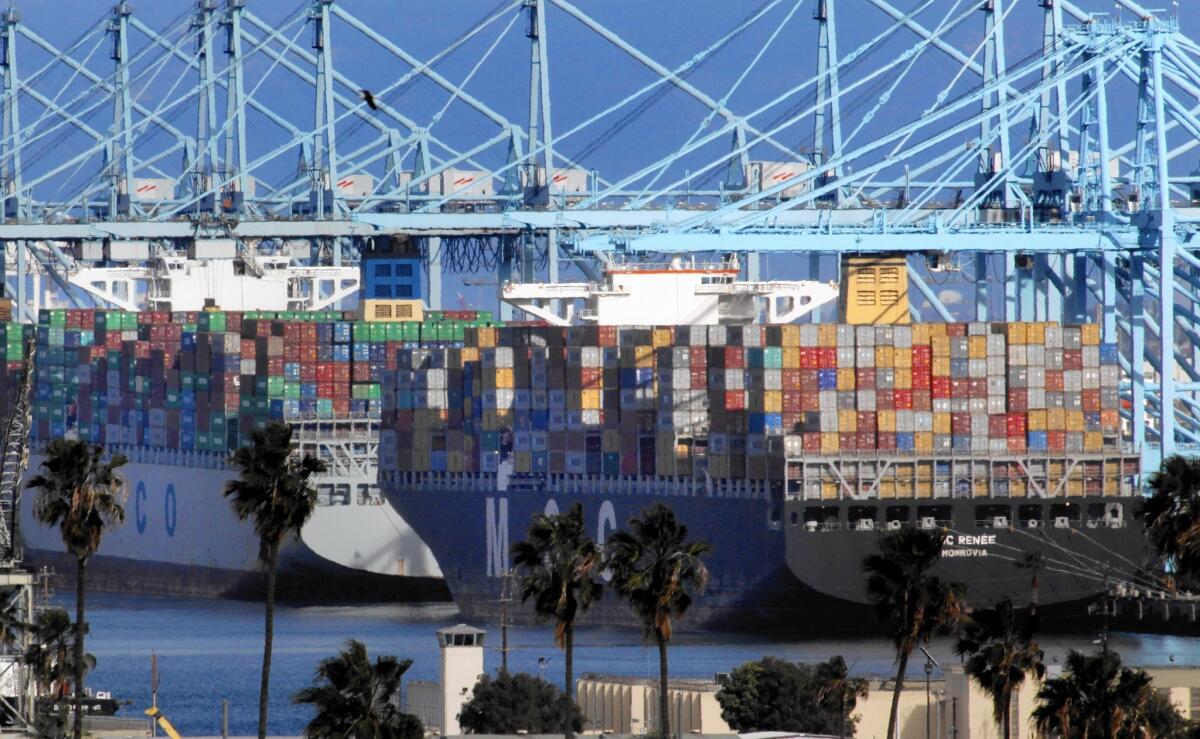Trade jobs in Southern California have jumped, but policy and labor challenges loom

- Share via
Southern California has experienced a boost in trade and logistics employment in the last decade, but policy and labor challenges lie ahead, according to a new economic report.
Trade-related jobs increased nearly 10% from 2005 to 2015, more than double the overall regional employment increase of 4.2%, the report released Monday by the Los Angeles County Economic Development Corp. found.
Warehousing and logistics jobs led the charge, jumping 55.1% over the decade, said the report, titled “Trade & Logistics in Southern California.”
The growth came at a cost, however. Wages in warehousing dropped 9% during the period, compared with an increase of almost 3% in the industry overall, which includes the highly paid dockworkers at the ports of Los Angeles and Long Beach, the nation’s largest cargo complex.
The average trade industry worker still made more than $63,000 in 2015, about 14% higher than the average wage for other industries in the area.
Shannon Sedgwick, an economist with the L.A. County Economic Development Corp., attributed some of the employment growth to the decentralization of warehousing and distribution. Consumers are demanding faster shipping, which forces companies to move warehouses closer to population centers to save time and money.
“Distribution is becoming more localized, and more localized growth means more new facilities,” Sedgwick said. “That means job growth.”
The job growth has also coincided with major technological advancements in the industry that increase productivity.
Automation and robotics technology enables companies to “maximize their footprint” by stacking products in warehouses, Sedgwick said. These facilities often reach above 40 feet and use automated vertical tracking systems to place pallets higher than previously possible with older systems.
For now, these machines don’t hinder jobs because laborers are still needed to pick many items and move them onto trucks.
“When they create a robot that accurately and efficiently picks the order … that will be a drag on job growth,” Sedgwick said.
Trade and logistics is vital to Southern California, accounting for around 13% of the regional domestic product, according to the report. In 2015, 598.3 million tons of freight valued at $1.7 trillion moved through the region.
Including the half a million people directly employed in the industry, trade supports 1.2 million jobs in the region.
Sedgwick predicts the industry will focus on increasing efficiency through innovations in technology to overcome the looming challenges on the horizon, which include trade policy, environmental regulation and recurring labor disputes.
President Trump’s repeated threats to impose punitive tariffs on Chinese imports are a cause for concern for the industry.
Last year, a Chinese investment company bought Irvine electronics distributor firm Ingram Micro for $6 billion, marking the largest acquisition of an American tech company by a Chinese firm. Chinese money is also pouring into Temecula, Southern California’s wine region, where investors are funding at least five major projects.
“Any major shift from the Trump administration — misguided as it may be — could have a substantial impact on our ports,” said Jock O’Connell, international trade advisor for Beacon Economics.
International freight flowing through the region accounts for 22% of volume but 36% of total value because foreign trade flows have an average value of $4,800 per ton versus $2,300 for domestic flows.
O’Connell also said the industry is concerned about increasingly strict environmental regulations from the California Air Resources Board.
He estimates that the cost of complying with new regulations and implementing new equipment will total $35 billion over the next two or three decades, as opposed to the $7 billion it would cost to keep the current equipment functioning.
“The implementation of air quality standards is expensive,” O’Connell said. “The real question is whether ports … will collectively be able to afford the tens of billions of dollars it will cost to comply.”
Twitter: @jflem94
More to Read
Inside the business of entertainment
The Wide Shot brings you news, analysis and insights on everything from streaming wars to production — and what it all means for the future.
You may occasionally receive promotional content from the Los Angeles Times.











